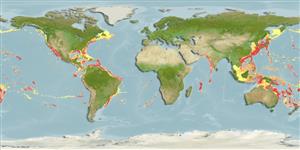Common names from other countries
Classification / Names / Names
ชื่อสามัญ | ชื่อพ้อง | Catalog of Fishes (gen., sp.) | ITIS | CoL | WoRMS
Environment: milieu / climate zone / depth range / distribution range
นิเวศวิทยา
ผิวน้ำ; ระดับความลึก 0 - 1300 m (Ref. 275). Tropical; 55°N - 38°S, 59°E - 8°E (Ref. 275)
Circumglobal in tropical to temperate waters.
Length at first maturity / ขนาด / น้ำหนัก / Age
Maturity: Lm ?, range 10 - 20 cm Max length : 22.7 cm ML เพศผู้/กระเทย; (Ref. 104052); 180 cm ML (female); น้ำหนักสูงสุดที่มีการรายงาน: 235.00 g (Ref. 97142)
Geographical variability of size at maturity and size morphology is pronounced. Maximum size and size at maturity increases from the low latitudes to the high latitudes (Ref. 97142). Incidentally caught by jigs (Ref. 275). True bi-peripheral oceanic species. Epipelagic and upper mesopelagic; distributed from the surface to 400 m. Inhabits open waters, mostly over great depths of more than 200 m, and is neither associated with the bottom nor slope habitats. Subadult and adult squids occasionally observed at the surface at night. Inhabit depths greater than 50 to 100 m during the day. Low or moderately abundant locally (especially in the South Pacific Ocean between 30°S and 40°S). Life span is a maximum of 1 year. Spawning occurs throughout most of the year in the lower latitudes, and during spring and summer seasons in the higher latitudes. This species is an intermittent, multibatch spawner. Prey organisms include many species of pelagic crustaceans, heteropod molluscs and larvae and juveniles of teleost fishes and squids. The known predators include lancetfish (Alepisarus ferox), shark (Sphyrna zygaena), different species of tunas, the trichichthyid fish, orange roughy (Haplostethus atlanticus), sea birds and northern fur seal. Off eastern Australia, it is preyed upon by yellowfin tuna (Thunnus albacares) and swordfish (Xiphias gladius) in the warmer surface waters associated with the East Australia Current. Most subadult and adult squids are infested with helminth parasites: larvae of nematodes and cestodes and metacercariae of trematodes of the family Didymozoidae. All forms of parasites mainly are localized on the inner wall of the stomach (Ref. 97142).
Life cycle and mating behavior
วัยเจริญพันธุ์ | การสืบพันธุ์ | การวางไข่ | เซลสืบพันธ์ของเพศเมีย(ไข่) | ความดกของไข่ | ตัวอ่อน
Members of the class Cephalopoda are gonochoric. Male and female adults usually die shortly after spawning and brooding, respectively. Mating behavior: Males perform various displays to attract potential females for copulation. During copulation, male grasp the female and inserts the hectocotylus into the female's mantle cavity where fertilization usually occurs. Life cycle: Embryos hatch into planktonic stage and live for some time before they grow larger and take up a benthic existence as adults.
Roper, C.F.E., M.J. Sweeney and C.E. Nauen. 1984. (Ref. 275)
IUCN Red List Status (Ref. 130435)
CITES status (Ref. 108899)
Not Evaluated
Not Evaluated
Human uses
การประมง: ไม่มีผลประโยชน์
| FishSource |
เครื่องมือ
ข้อมูลเพิ่มเติม
Age/SizeการเจริญเติบโตLength-weightLength-lengthสัณฐานวิทยาตัวอ่อนอุดมสมบรูณ์
แหล่งที่มาจากอินเตอร์เน็ต
Estimates based on models
Preferred temperature
(Ref.
115969): 2.7 - 19.2, mean 11.9 (based on 706 cells).
Vulnerability
Low vulnerability (10 of 100).
